英语专业翻译方向论文完整版
- 格式:doc
- 大小:78.50 KB
- 文档页数:14
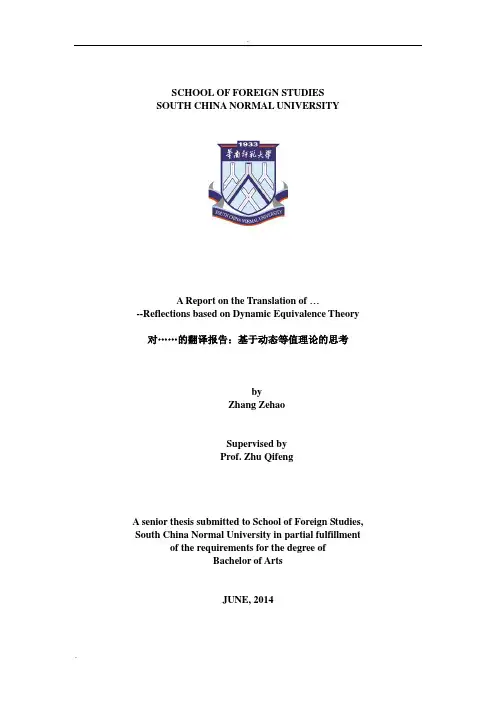
SCHOOL OF FOREIGN STUDIESSOUTH CHINA NORMAL UNIVERSITYA Report on the Translation of …--Reflections based on Dynamic Equivalence Theory 对……的翻译报告:基于动态等值理论的思考byZhang ZehaoSupervised byProf. Zhu QifengA senior thesis submitted to School of Foreign Studies, South China Normal University in partial fulfillment of the requirements for the degree ofBachelor of ArtsJUNE, 2014Declaration of AuthorshipABSTRACTThis report is on the t ranslation of … . It is the author’s translation reflections and discussions based on Dynamic Equivalence Theory. …Three case studies are offered …The present report shows that … This report offers some suggestions for future translation practitioners…Key words: the first; the second; the third中文摘要本报告报导了对……的翻译实践情况,是作者基于动态等值理论对自己翻译实践的反思与讨论。
……报告分析了三个案例……本报告表明……本报告为未来的翻译实践者们提出的建议是……关键词:关键词1;关键词2;关键词3Table of ContentsABSTRACT (I)中文摘要 ......................................................................................................................................... I I Chapter One Introduction .. (1)1.1 Background (1)1.2 Purpose of the Translation/Interpretation Practice (1)1.3 Structure of the Present Report ........................................................ 错误!未定义书签。

Thesis: the process of translation invarious strategies and skills"[to] the article tells how to pick the faithful to the original language smooth into the target language, summarizes some basic skillsin english-chinese translation of application.[key words] english-chinese translation; Translation skills; applicationTranslation is the bridge of communication two languages, to the source language expression come out information, a target to express,and two languages need to deal with. Because the two kinds of language expression and usage habits are different, in the process of translating best can make use of various translation skills to target for some changes and change to comply with the expression of the target language habits. Below summarizes the nine kinds of common translation skills.A, the choice of word meaning, extension and praise or blame for translators, dictionary can only provide the most basic definitions, the translation of extended, choice and pay attention to the praise or blame. As long as the basic meaning with the word, you can, in order to adaptto the ever-changing the need, the text unobstructed, rich and colorful, vivid and lively.1. Select Chinese and English word meaning of all have abundant vocabulary, but two languages corresponding term can absolutely, polysemy is two kinds of language in terms of the common features. Therefore, when translation must make clear the original sentence structure, after carefully choose determine meaning. For example: (1)The soul experiences completing a down cycle. 商业周期经历l突然的萧条。
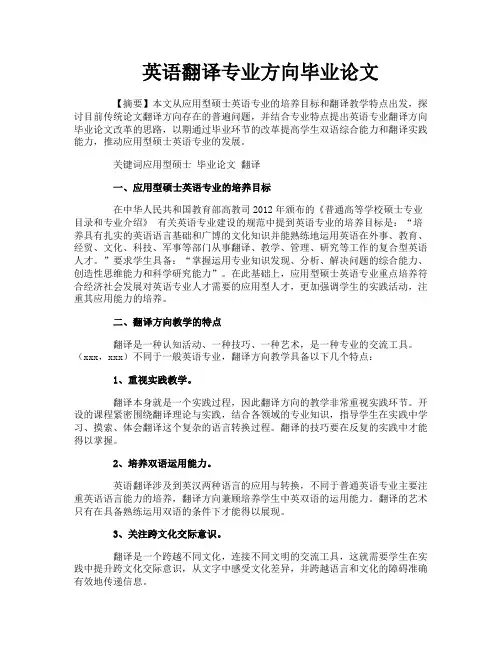
英语翻译专业方向毕业论文【摘要】本文从应用型硕士英语专业的培养目标和翻译教学特点出发,探讨目前传统论文翻译方向存在的普遍问题,并结合专业特点提出英语专业翻译方向毕业论文改革的思路,以期通过毕业环节的改革提高学生双语综合能力和翻译实践能力,推动应用型硕士英语专业的发展。
关键词应用型硕士毕业论文翻译一、应用型硕士英语专业的培养目标在中华人民共和国教育部高教司2012年颁布的《普通高等学校硕士专业目录和专业介绍》有关英语专业建设的规范中提到英语专业的培养目标是:“培养具有扎实的英语语言基础和广博的文化知识并能熟练地运用英语在外事、教育、经贸、文化、科技、军事等部门从事翻译、教学、管理、研究等工作的复合型英语人才。
”要求学生具备:“掌握运用专业知识发现、分析、解决问题的综合能力、创造性思维能力和科学研究能力”。
在此基础上,应用型硕士英语专业重点培养符合经济社会发展对英语专业人才需要的应用型人才,更加强调学生的实践活动,注重其应用能力的培养。
二、翻译方向教学的特点翻译是一种认知活动、一种技巧、一种艺术,是一种专业的交流工具。
(xxx,xxx)不同于一般英语专业,翻译方向教学具备以下几个特点:1、重视实践教学。
翻译本身就是一个实践过程,因此翻译方向的教学非常重视实践环节。
开设的课程紧密围绕翻译理论与实践,结合各领域的专业知识,指导学生在实践中学习、摸索、体会翻译这个复杂的语言转换过程。
翻译的技巧要在反复的实践中才能得以掌握。
2、培养双语运用能力。
英语翻译涉及到英汉两种语言的应用与转换,不同于普通英语专业主要注重英语语言能力的培养,翻译方向兼顾培养学生中英双语的运用能力。
翻译的艺术只有在具备熟练运用双语的条件下才能得以展现。
3、关注跨文化交际意识。
翻译是一个跨越不同文化,连接不同文明的交流工具,这就需要学生在实践中提升跨文化交际意识,从文字中感受文化差异,并跨越语言和文化的障碍准确有效地传递信息。
三、传统翻译类学术论文的普遍问题从选题上来看,根据多位学者的调查统计,相较于文学或文化领域,英语专业的学生真正选择翻译理论研究方向的相对较少(xxx,20xx),这是因为翻译方向的参考资料相对来说专业度高,抽象难懂,有的研究涉及大量的数据收集和统计,这些都使学生望而却步。
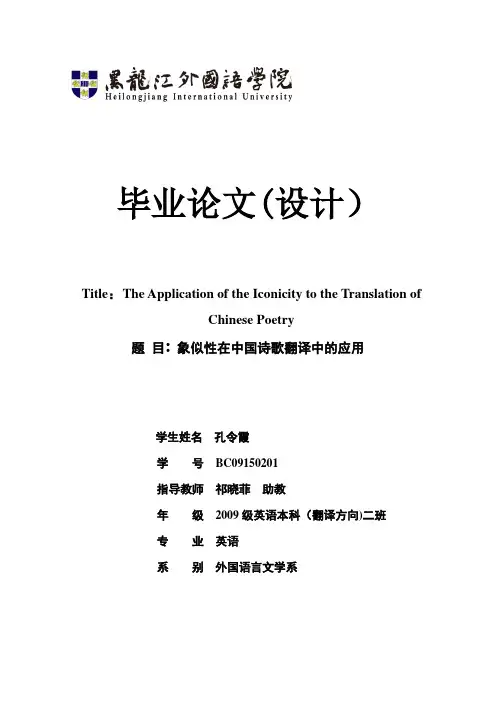
毕业论文(设计)Title:The Application of the Iconicity to the Translation ofChinese Poetry题目:象似性在中国诗歌翻译中的应用学生姓名孔令霞学号BC09150201指导教师祁晓菲助教年级2009级英语本科(翻译方向)二班专业英语系别外国语言文学系黑龙江外国语学院本科生毕业论文(设计)任务书摘要索绪尔提出的语言符号任意性,近些年不断受到质疑,来自语言象似性的研究是最大的挑战。
语言象似性理论是针对语言任意性理论提出来的,并在不断发展。
象似性是当今认知语言学研究中的一个重要课题,是指语言符号的能指与所指之间的自然联系。
本文以中国诗歌英译为例,探讨象似性在中国诗歌翻译中的应用,从以下几个部分阐述:(1)象似性的发展;(2)象似性的定义及分类;(3)中国诗歌翻译的标准;(4)象似性在中国诗歌翻译中的应用,主要从以下几个方面论述:声音象似、顺序象似、数量象似、对称象似方面。
通过以上几个方面的探究,探讨了中国诗歌翻译中象似性原则的重大作用,在诗歌翻译过程中有助于得到“形神皆似”和“意美、音美、形美”的理想翻译效果。
关键词:象似性;诗歌;翻译AbstractThe arbitrariness theory of language signs proposed by Saussure is severely challenged by the study of language iconicity in recent years。
The theory of iconicity is put forward in contrast to that of arbitrariness and has been developing gradually。
Iconicity,which is an important subject in the research of cognitive linguistics, refers to a natural resemblance or analogy between the form of a sign and the object or concept。
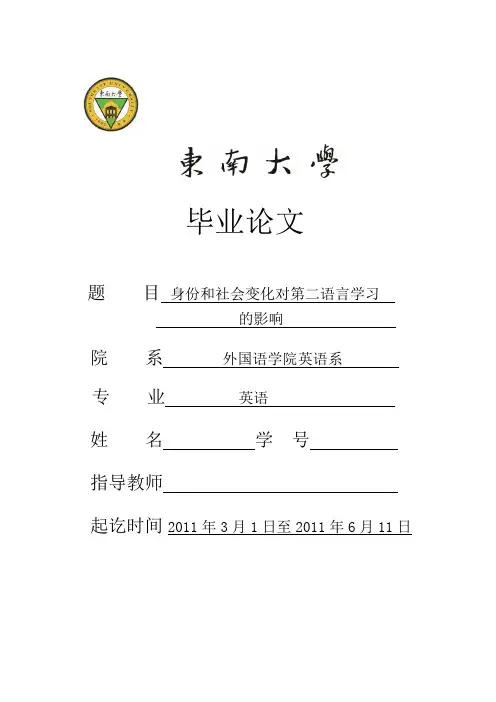
毕业论文题目身份和社会变化对第二语言学习的影响院系外国语学院英语系专业英语姓名学号指导教师起讫时间2011年3月1日至2011年6月11日The Effects of Identity and Social Change on Second LanguageLearningByWang MingUnder the Supervision ofProfessor Li PingSubmitted in Partial Fulfillment of the Requirements For the Degree of Bachelor of ArtsEnglish DepartmentSchool of Foreign LanguagesSoutheast UniversityJune 2011东南大学学位论文独创性声明本人声明所呈交的学位论文是我个人在导师指导下进行的研究工作及取得的研究成果。
尽我所知,除了文中特别加以标注和致谢的地方外,论文中不包含其他人已经发表或撰写过的研究成果,也不包含为获得东南大学或其他教育机构的学位或证书而使用过的材料。
学生签名:日期:东南大学学位论文使用授权声明东南大学外国语学院有权保留本人所送交学位论文的复印件和电子文档,可以采用影印、缩印或其他复制手段保存论文。
本人电子文档的内容和纸质论文的内容一致。
除在保密期的保密论文外,允许论文被查阅和借阅,可以公布(包括刊登)论文的全部或部分内容。
论文的公布(包括刊登)授权东南大学外国语学院办理。
学生签名:导师签名:日期:AcknowledgementsHere I would like to express my deepest gratitude to those people without whose assistance and encouragement this thesis would never be completed.My gratitude first goes to Professor XXX. As my academic supervisor, Ms. X has guided me all through the process of thesis-writing. With her profound insights and expert advice, I have really learned a lot about data collection and analysis as well as how to organize a thesis wisely. Ms. X spares no pains in correcting the mistakes in my thesis. She always shares her ideas with me, which enables me to make valuable improvements. I am much inspired and encouraged by Ms. X’s academic spirit and knowledge.I would also like to extend my thanks to my parents who have brought me to this wonderful world. Under their considerate care and endless love, I have grown to be a university student.Lastly, I deliver my best wishes to all my good friends. Whenever I need help, they are ready to do me a favor. They share with me their opinions on some topics in thesis writing and contribute their ideas unselfishly. In talking with them, I can always come up with some fascinating ideas.(本模板仅做格式参考,内容不做参考)AbstractIn this review article on identity, language learning, and social change, we argue that contemporary poststructuralist theories of language, identity, and power offer new perspectives on language learning and teaching, and have been of considerable interest in our field. We first review poststructuralist theories of language, subjectivity, and positioning and explain sociocultural theories of language learning. We then discuss constructs of Investment and Imagined Communities/Imagined Identities, showing how these have been used by diverse identity researchers. Illustrative examples of studies that investigate how identity categories like race, gender, and sexuality interact with language learning are discussed.Common qualitative research methods used in studies of identity and language learning are presented, and we review the research on identity and language teaching in different regions of the world. We examine how digital technologies may be affecting language learners’identities, and how learner resistance impacts language learning. Recent critiques of research on identity and language learning are explored, and we consider directions for research in an era of increasing globalization. We anticipate that the identities and investments of language learners, as well as their teachers, will continue to generate exciting and innovative research in the future.Keywords:identity;language learning;social change(本模板仅做格式参考,内容不做参考)摘要概念隐喻理论自20世纪80年代以来逐渐发展成为认知语言学领域的一个十分火热的研究焦点。
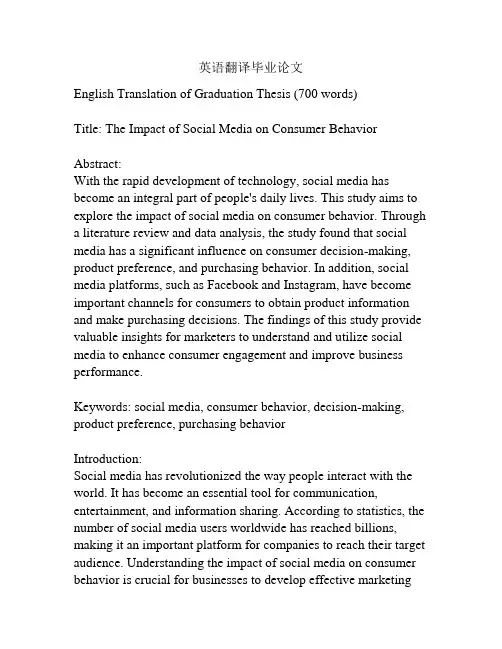
英语翻译毕业论文English Translation of Graduation Thesis (700 words)Title: The Impact of Social Media on Consumer Behavior Abstract:With the rapid development of technology, social media has become an integral part of people's daily lives. This study aims to explore the impact of social media on consumer behavior. Through a literature review and data analysis, the study found that social media has a significant influence on consumer decision-making, product preference, and purchasing behavior. In addition, social media platforms, such as Facebook and Instagram, have become important channels for consumers to obtain product information and make purchasing decisions. The findings of this study provide valuable insights for marketers to understand and utilize social media to enhance consumer engagement and improve business performance.Keywords: social media, consumer behavior, decision-making, product preference, purchasing behaviorIntroduction:Social media has revolutionized the way people interact with the world. It has become an essential tool for communication, entertainment, and information sharing. According to statistics, the number of social media users worldwide has reached billions, making it an important platform for companies to reach their target audience. Understanding the impact of social media on consumer behavior is crucial for businesses to develop effective marketingstrategies.Literature Review:Numerous studies have been conducted to investigate the influence of social media on consumer behavior. Some studies have found that social media has a significant impact on consumer decision-making. For example, Lam et al. (2016) found that social media plays an important role in shaping consumer attitudes and perceptions towards a brand. Consumers tend to trust information obtained from social media platforms more than traditional advertising methods. This trust leads to increased brand loyalty and purchase intention.On the other hand, social media has also been found to influence product preference. Consumers often rely on social media recommendations and reviews to make purchase decisions. Lin et al. (2017) found that positive reviews and high ratings on social media platforms significantly increase consumers' willingness to purchase a product. This indicates that companies should actively engage with consumers on social media and encourage positive reviews to enhance product preference.Furthermore, social media has a direct impact on consumers' purchasing behavior. Research by Smith (2018) revealed that social media platforms have become important channels for consumers to obtain product information and make purchasing decisions. Consumers often scroll through their social media feeds and come across product advertisements or recommendations. These social media interactions directly influence their purchasing behavior, leading to increased sales for businesses.Methodology:To investigate the impact of social media on consumer behavior, this study conducted a survey involving 300 participants. The survey consisted of questions related to consumer decision-making, product preference, and purchasing behavior. The data collected was analyzed using statistical methods to identify correlations and trends.Results and Discussion:The data analysis showed a strong correlation between social media usage and consumer behavior. A majority of the participants indicated that they regularly used social media platforms to gather product information and make purchasing decisions. Additionally, positive reviews and recommendations from social media influencers were found to significantly influence consumer purchasing behavior.Conclusion:This study concludes that social media has a significant impact on consumer behavior. Companies should leverage social media platforms to engage with consumers, build brand loyalty, and enhance product preference. Strategies such as influencer marketing and encouraging positive reviews can effectively drive sales and improve business performance.。
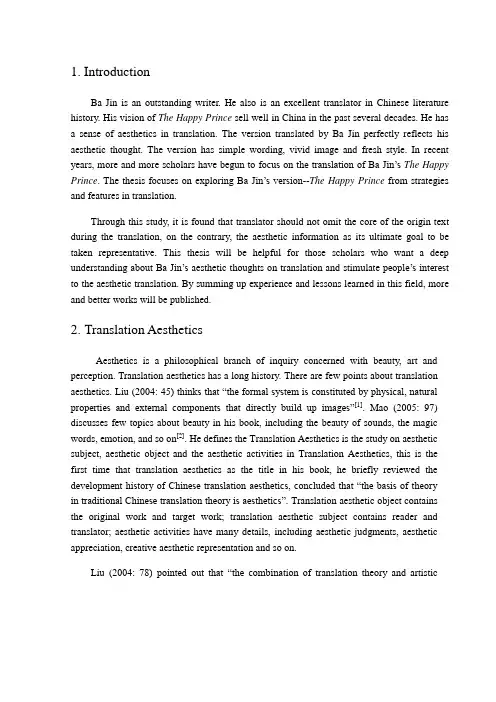
1. IntroductionBa Jin is an outstanding writer. He also is an excellent translator in Chinese literature history. His vision of The Happy Prince sell well in China in the past several decades. He has a sense of aesthetics in translation. The version translated by Ba Jin perfectly reflects his aesthetic thought. The version has simple wording, vivid image and fresh style. In recent years, more and more scholars have begu n to focus on the translation of Ba Jin’s The Happy Prince. The thesis focuses on explor ing Ba Jin’s version--The Happy Prince from strategies and features in translation.Through this study, it is found that translator should not omit the core of the origin text during the translation, on the contrary, the aesthetic information as its ultimate goal to be taken representative. This thesis will be helpful for those scholars who want a deep understanding about Ba Jin’s aesthetic thoughts on translation and stimulate people’s interest to the aesthetic translation. By summing up experience and lessons learned in this field, more and better works will be published.2.Translation AestheticsAesthetics is a philosophical branch of inquiry concerned with beauty, art and perception. Translation aesthetics has a long history. There are few points about translation aesthetics. Liu (2004: 45) thinks that “the formal system is constituted by physical, natural properties and external components that directly build up images”[1]. Mao (2005: 97) discusses few topics about beauty in his book, including the beauty of sounds, the magic words, emotion, and so on[2]. He defines the Translation Aesthetics is the study on aesthetic subject, aesthetic object and the aesthetic activities in Translation Aesthetics, this is the first time that translation aesthetics as the title in his book, he briefly reviewed the development history of Chinese translation aesthetics, concluded that “the basis of theoryin traditional Chinese translation theory is aesthetics”. Translation aesthetic object contains the original work and target work; translation aesthetic subject contains reader and translator; aesthetic activities have many details, including aesthetic judgments, aesthetic appreciation, creative aesthetic representation and so on.Liu (2004: 78) pointed out that “the combina tion of translation theory and artisticaesthetics is the basic characteristics of Chinese traditional translation theory”[1] in his book,in which he analyzes the aesthetic subject and aesthetic object briefly. Translation is a progress, including comprehension, transformation and improvement.2.1 Aesthetic SubjectNida (1963: 45) said “Translator is the aesthetic subject. A good target text not only has a bearing on the aesthetic constituents of its aesthetic object, but also has a bearing on the aesth etic subject’s ability. When they are both in the integrating aesthetic relationship, translating, as the progression of aesthetic representation, should be endowed aesthetic effect”[3]. Fu (1993:79) states that there are two aesthetic subjects during translating work--translator and receptor[4].Translator plays a very important role in translation. Aesthetic subjects refer to those people who can make judgment under the specific condition. Aesthetic subject is called “second reality[5]” by Tytler (2009: 32) because it is different form reality, and it has two types: translators and readers. Translator is the aesthetic subject of origin works, while reader is the aesthetic subject of the target works. Translators play a crucial role in translation. Translator should understand the works first, and then transform the meaning to target works. Translator is a active part in aesthetic translation. Considering the receptors, Mark (1997: 124) thinks that translator not only transform the main meaning to target work, but also aesthetic consciousness, culture accomplishment and aesthetic experience[6].Lao Zi (1999: 223) holds translator is the aesthetic subject of target text, he plays a very important role in perceiving, judging and evaluating original text and transforming every detail into target text, the deeper he understands the original text, the higher the quality of translation work would be[7].Liu (2004: 35) thinks that the translator should start translating work from the children’s angle[1]. So it is indispensable that the translator to master three aesthetic conditions: aesthetic consciousness, culture accomplishment and aesthetic experience .(1)aesthetic consciousnessAesthetic consciousness refers to the perception of aesthetics or a sense of aesthetics,they are from translator’s in stinct. In children’s world, everything is so quite and simple, everyone is so friendly, their thoughts are very different from adults’. If children think the world is imbalance after reading a book, the book is not a good one.(2)culture accomplishmentA good translator should have original language knowledge, target language knowledge and other related professional knowledge. As a translator of children’s literature, the necessary knowledge is to know characteristics a t different ages. If the translator apply children’s language for adult, it should be very ridiculous to read such a translated work.(3)aesthetic experienceAs a translator, he must have enough vocabulary as well as syntactic resources, and he can use them flexibly in different situations. During translating works, translators should master translation methods, which will be helpful to make him acquire his aesthetic experience. For translators, aesthetic experience is quite important, especially in the tr anslation of children’s literature.Reader can be divided into two types-- adult and children. As readers, they are quite different. Adults have their own aesthetic standards. During reading works, they won’t accept the information from target works. Because they are capable of judging, evaluating and appreciating what they read. Also they can comprehend the knowledge that they have never heard, Their experience and relevant knowledge offer translators convenience to translate target works. While children are quite different from adults, children like literature which describe truth, beauty, honesty and kindness. They think that it is full of peace and love in the world around them. Children are curious, they will pay all their attention to new scene or environment, no matter it is bad or good.2.2 Aesthetic ObjectAccording to Liu’s(2004: 35) opinion, aesthetic object refers to source text[1]. Its aesthetic values should be founded upon its aesthetic constituents. There are two categories, one is aesthetic superstratum elements, which refers to the features of the form of a language such as the characteristics of its phonology, lexicon and syntax. It is called the beauty of form in aesthetics, such as image, style of source text. It could be perceived directly. The other constituent is non-superstratum. There is no direct relationship between it and linguistic form.E (1978)has quite different idea from Liu (2004), he thinks that aesthetic object includessource text and target text[8] . As real re flection of the reality, aesthetic object is called “third reality”by Zhi (2006)[9] . Aesthetic objects can cater to people’s aesthetic needs. Liu (2004) divided aesthetic objects into two terms: form system and non-form system[1].Form system has two salient features. Firstly, it relates to susceptible feelings. Secondly, that form is a complicated conception.According to Liu’s opinion(2005), the non-form aesthetic constituents can be divided into four scopes: sentiments, ideals, images and symbols[1].3.Ba Jin’s Aesthetic Thoughts in TranslationAs we all know, Ba Jin’s works are the solid foundation in Chinese literature, as a famous novelist in literary world, he has abundant aesthetic thoughts on translation. He provides lots of works for us. But few scholars pay attention to his aesthetic thought. He is famous for his novel in the modern literature world. Literature world pays more attention to his works at the beginning of his creation. But the study on his aesthetic thought in his novel has not been given sufficient attention. It is necessary to explore and summarize Ba Jin’s aesthetic thought. Ba Jin’s translation benefits from his extensive knowledge. Through the translation practic on children’s literature, Ba Jin acquires a lot p recious experience, also he has a childlike heart, which makes children bound up in his works. All these experiences make him to become a first-class translator, and to achieve a great success in translation.3.1 Ba Jin’s Career as TranslatorBa Jin is a writer, also is a productive translator. All people know him as the writer's identity, but few people know his identity as a translator. He had built numerous characters. What he does in translation and writing pushes him to be an outstanding scholar. Many foreigners seek advice form him constantly. Ba Jin’s aesthetic thought in translation in the process of his translation work come from his accomplishment in Chinese language and English language, his rich experience and writing talent, his unassumingness and perseverance, etc... Generally speaking, all of these qualities play a crucial role in thecomprehension and replication of aesthetics in The Happy Prince.Ba Jin has the idea of translating The Happy Prince few decades age, but he just didn’t dare to start. He decides to start the translation work in middle March of 1942. In the rest time of 1942, Ba Jin finished a portion of translation, three short stories--The Selfish Giant, The Happy Prince and The Nightingale and the Rose. After that moment, he was disappointed to his own translation, so he lost confidence suddenly. The more worse thing happened during the war in 1944, his handwriting were burned after he put them back to the bookrack. Ba Jin didn’t give up, he started again in 1946, two years lat er, he ultimately finished the translating. Thinking back, we can notice that the new start is good for the translation, because he became more mature in choosing words and dealing with the different cultures than the first time, also he had a deep understanding to the source work during such a long time. Ba Jin is worthy of our respect,no matter as a writer or translator.3.2 Ba Jin’s Aesthetic Translation ThoughtsThere is no standard for the definition of children’s literature, it has its own characteri stics. Firstly, the details in children’s literature are dramatic and easy to understand, story lines are beneficial for promotion of the children’s interests, wit and taste. Secondly, children’s literature has an education function. Its language is meanin gful, simple stories illustrate the profound truth. Thirdly, children are the target receiptor of children’s literature, so the language should be full of childlike innocence. In this way, can the works win the favor of children, to attract more readers.C hildren’s literature is quite different from adult literature. The former needs more special attention. Through years study in translation and language, Ba Jin has his own untouchable thoughts on translation.3.2.1 Ba Jin’s Language Features in TranslationWhen people talk about Ba Jin’s translation, they always concern with literal translation. Ba Jin shows children’s world on different levels.Firstly of all, Ba Jin’s language is very simple and colloquial. Children’s literature has become a hot topic in recent years. More and more translators and writers have realized that receiptors preferred to hear the sound of words and phrases. To meet the needs of children for rhythm and sounds, writers and translators try to make the language of their works sound nice,vivid and smooth. Ba Jin’s works are well-known, because some works written or translated by him are looked as stories. His wording is simple and easy to understand, readers, especially young readers feel familiar to the language, also it is benefit to understand other narration.Secondly, the most foregrounded during Ba Jin’s translation is the sound beauty. In children’s language, musical sound and noticeable characteristics are indispensable. We can find that there are so many interjection, exclamation and onomatopoeia in the conversation. Some writers and translators regard it as trivial or useless details, in fact, these elements are very important for translation. They are helpful to make the conversation more lively and interesting, attracting mo re young readers. Ba Jin’s translation sets a good example in this respect.Lastly, Ba Jin focuses on the literal translation. He won’t omit every source language point. The target readers are European, so we can find Europeanized sentences in his works. These structures cause difficulties in understanding for children, however, as we all know, the readers and receiptors are not only the children, but also adults, it sounds reasonable.3.2.2 Ba Jin’s Aesthetic Attitude in TranslationThe aesthetic attitude is defined as the attitude to the aesthetic objects. It is influenced by many factors. One of the most factors is the inner desire and interest, it always exists in our minds.During the translation, the translators may extend the emotion or express his own sentiment if he love the original writer or this work, also he may take a quite initiative in the process of translation. Just as the excellent translator Roman (1959: 93) said, there are two standards to judge whether a translator is befitting to translate a original work. The first is wether the translator has interest in the source work, or the translator enjoys the source work; The second standard is whether the translator has eyes to find every artistic element[10].Ba Jin says, he just chose those works which cater for his emotion or taste. His first translating is Signal, he has a great enthusiasm for this book, and his own sensibilities in it.Sometimes Ba Jin not totally goes along with the original authors, but every work is excellent in his eyes. He wants to open his heart to the readers through his own works and translation. Initially, Ba Jin was just trying to translate, while after he finished, he would be quite excited and very appreciate his own achievements.Wilde’s fairytales have few Si gnificant features, such as beautiful and integrated style, the poetic language and the musical tone. Ba Jin was interested in them. He praised Wilde from the bottom of his heart. Wilde is a writer famous for his childlike language and his beautiful works, and he has his own characteristic style and rhetoric. Ba Jin said that he learned how to be a straight shooter after translating work.This positive aesthetic attitude to ensure Ba Jin's insistence, even in a bad situation he can modify his manuscripts and finish the translating.Ba Jin and Wilde hold a similar idea on the importance of the form, they both think that form has a major influence on the literary. Ba Jin thinks that inferior should serve content, and he firmly believe that translators and writers in China never stop seeking for a form which can express their ideas freely. Wilde often regards form as the start point for the creation of works, the next one is ideas and then devotion. The form should be suitable for conveying original writer’s emotion incisively and vividly, attract more receiptors, and enhance the reader’s sense of aesthetics.A literature work can have many translators and countless readers. Every translator expresses his own aesthetic thoughts in his translating through his unique method. Each of them does their utmost to be faithful to the source work, but it cannot stop permeating the embodiment of personal judgment on aesthetics in translation. Ba Jin has his own principle in translation is that he tries his best to be faithful to the source work.Ba Jin focuses on the creative power during the translation. He has always insisted on the tone and style, this is the reason why so many people love Ba Jin’s visions.4. Ba Jin’s Aesthetic Translation in The Happy PrincePart three provides a brief introduction to Ba Jin as a translator, and his unique aesthetic thoughts in translation. In this part it is requisite to analyze Ba Jin’s achievement in translating works. Ba Jin translated version The Happy Prince is very popular in a period of time. Therefore, this study takes Ba Jin’s vision of The Happy Prince as an example to explore the aesthetics in the source work, to explore Ba Jin’s concrete manifestation of aesthetic elements in his vision, and how he takes aesthetic enjoyment to target readers.In fact, the key point of translation work is to make the target text to the maximum extent similar with the original text in aesthetics. No translator can produce a perfect text. If an imperfect to be a consummate one by translating, it is regarded as a palimpsest, not translation. In Yan’s opinion (1998: 167), aesthetic thoughts can be embodied in many ways, such as theNationalization issues of the beauty of form; the filiation between national cultures and the beauty of form; the relation between form and content; how to make the aesthetic ideality to be specific things[11].Before explore the aesthetic thoughts in translation, it is helpful to analyze the aesthetic features in The Happy Prince. For clarity, this thesis probe into the aesthetic thoughts in Ba Jin’s vision from three aspects: poetic language, image and style, these aspects are interdependent to each other in an organic whole and even overlap in some cases.4.1 Representation of the Poetic Language of The Happy PrinceIn literary art, scholars always regard language as the vehicle. Readers are attracted by literary language firstly when read writings. If the art cannot attract reader’s attention with best story and original concept, it indicates that there is no good language. Language is like outerwear of writings, it contains words, phrases, sentence, paragraphs and discourses. There are many details in the process of expressing aesthetic thoughts and showing the original images, such as grammar, sentence structure and logic and so on.Beauty of language is determined by many aspects, including the choosing of words, sentence patterns and other linguistic expressions. A complete translation starts from original text and ends up with target text, so the transfer process of aesthetic thoughts is also from the original text to the translation. The external aesthetic elements are regarded as the form of language, the connotative aesthetic elements are content. The content contains not only the meaning, tone and sound, but also lingering charm and mood.4.1.1 Features of Language in The Happy PrinceIn Wilde’s fairytales, the most prominent feature in language is smoothness. In Ba Jin’s vision of The Happy Prince, there is a prominent feature is poetic language, no matter in describing a scene, telling a scenario, or making a dialogue, the language is always vivid and smart.There are five stories in The Happy Prince--The Nightingale and the Rose; The Selfish Giant; The Devoted Friend and The Remarkable Rocket. They are all filled with fantastic imagination and delicate sarcasm with simple colloquial language. All these cater for tastes of children and adults. Ba Jin owns a good language foundation and rich writing and has a very high capacity in comprehending the original text and applying target language. All theseadvantages have a promoting effect on Ba Jin’s translating work. He transfers the beauty of original text at utmost to the vision of The Happy Prince. The beauty in the original language gets represented in the largest degree in his version of The Happy Prince.4.1.2 Specific Representation of Language in The Happy PrincePeople who read this book will be deeply touched by its story, like The Nightingale and the Rose, this story focuses on the representation of the process in which the nightingale pressed her breast against the thorn all night to make a red rose with her blood for the student she loved.......“Swallow, Swallow, little Swallow,” said the Prince, ‘”will you not stay with me for one night, and be my messenger? The boy is so thirsty,and the mother so sad” (Oscar Wilde1996:165)[12].......“燕子,燕子,小燕子,”王子要求说,“你难道不肯陪我过一夜,做一回我的信差么?那个孩子咳得太厉害了,他的母亲太苦恼了”(巴金2010:202)[13]。

毕业论文英文翻译专业范文商务英语翻译教学应注重拓展学生的商务专业知识,加深学生对不同商务体裁语篇的理解和感知。
下文是店铺为大家整理的关于毕业论文英文翻译的范文,欢迎大家阅读参考!毕业论文英文翻译篇1跨文化现象在商务英语翻译教学中的影响[摘要] 跨文化现象是社会交往的产物,在商务英语翻译的社会行为中,必然会受到跨文化现象的影响。
商务英语作为专业英语,自身具有专业性、客观性与时效性的特点,因此在进行商务英语翻译教学的时候,就必须根据商务英语的特点,注意跨文化现象在源语言和目的语言之间的作用,使翻译能达到“信、达、雅”的要求。
[关键词] 跨文化现象;商务英语翻译;教学对于语言学习者而言,语言的学习和文化的融合是一个统一的过程。
在语言学习的过程中,学习者不断地接受外来的文化,并与自身的文化不断碰撞,产生新的文化认识。
因此,没有脱离文化的语言学习,也没有离开语言工具的文化交流。
另一方面,商务英语以其自身的专业特点,形成特定的翻译方法,在教学过程当中,商务英语翻译和其他英语翻译的教学有着很大的区别。
作为商务英语的教学人员,要处理好翻译过程中跨文化现象所带来的问题,商务英语的特点和跨文化现象共同构成了处理好商务英语翻译教学的关键点。
一、跨文化现象的客观存在语言是文化的载体,语言担负起了文化传承的重任。
作为语言学习者,忽略文化学习语言,是不可能真正地把语言学好,学透。
胡文仲在《跨文化交际学概论》中提到:“只注意语言的形式,而不注意语言的内涵是学不好外语的”。
跨文化是社会交往的产物。
跨文化交往包括了跨种族、跨国家、跨民族、跨地区的交往,甚至人与人之间的交往本身都是两种不同的个人文化之间相互影响、相互融合的过程。
只要个体与个体之间进行交往,就会出现跨文化现象。
因此,我们必须有跨文化交往的自觉性。
在多元文化的影响下,无论从事任何行业,都会面对多元文化所带来的冲击。
而语言学习者可以说是首当其冲。
翻译作为语言学习的重要方面,自然要通过语言的形式,看到语言的内涵。
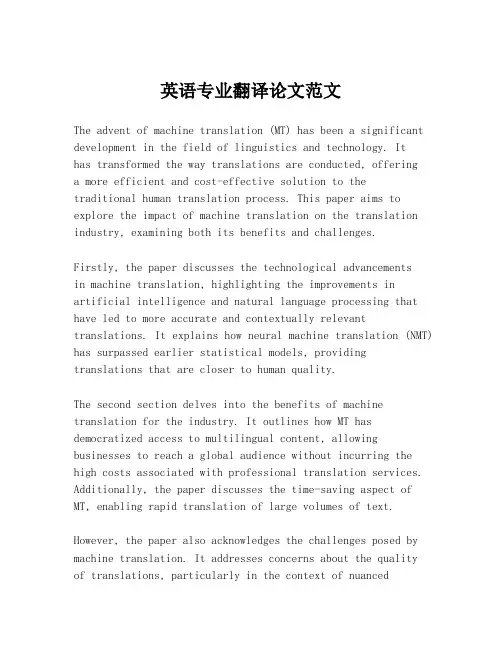
英语专业翻译论文范文The advent of machine translation (MT) has been a significant development in the field of linguistics and technology. Ithas transformed the way translations are conducted, offeringa more efficient and cost-effective solution to thetraditional human translation process. This paper aims to explore the impact of machine translation on the translation industry, examining both its benefits and challenges.Firstly, the paper discusses the technological advancementsin machine translation, highlighting the improvements in artificial intelligence and natural language processing that have led to more accurate and contextually relevant translations. It explains how neural machine translation (NMT) has surpassed earlier statistical models, providingtranslations that are closer to human quality.The second section delves into the benefits of machine translation for the industry. It outlines how MT has democratized access to multilingual content, allowing businesses to reach a global audience without incurring the high costs associated with professional translation services. Additionally, the paper discusses the time-saving aspect of MT, enabling rapid translation of large volumes of text.However, the paper also acknowledges the challenges posed by machine translation. It addresses concerns about the qualityof translations, particularly in the context of nuancedlanguage and idiomatic expressions, where MT often falls short. The potential for errors in critical documents, such as legal or medical texts, is also discussed, emphasizing the need for human oversight.Moreover, the paper examines the impact of MT on professional translators. It considers the fear of job displacement and the need for translators to adapt to the changing landscape by developing new skills, such as post-editing machine translations to ensure accuracy and fluency.In conclusion, the paper posits that while machinetranslation has revolutionized the translation industry, itis not a panacea. It suggests that a hybrid approach, combining the speed and efficiency of MT with the nuanced understanding of human translators, is the way forward. This approach can harness the best of both worlds, offering high-quality translations that meet the demands of today's interconnected world.References are provided to support the arguments presented in the paper, ensuring a well-researched and credible discussion on the topic. The paper concludes with a call to action for stakeholders in the translation industry to embrace the technological advancements while also nurturing the human element that is indispensable in the art of translation.。
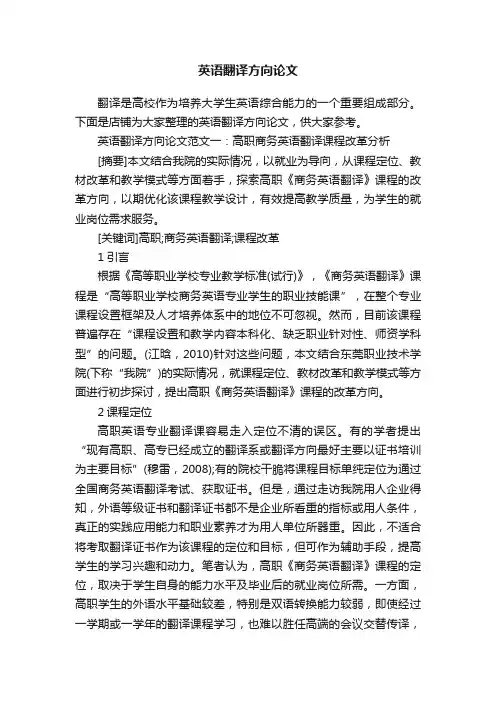
英语翻译方向论文翻译是高校作为培养大学生英语综合能力的一个重要组成部分。
下面是店铺为大家整理的英语翻译方向论文,供大家参考。
英语翻译方向论文范文一:高职商务英语翻译课程改革分析[摘要]本文结合我院的实际情况,以就业为导向,从课程定位、教材改革和教学模式等方面着手,探索高职《商务英语翻译》课程的改革方向,以期优化该课程教学设计,有效提高教学质量,为学生的就业岗位需求服务。
[关键词]高职;商务英语翻译;课程改革1引言根据《高等职业学校专业教学标准(试行)》,《商务英语翻译》课程是“高等职业学校商务英语专业学生的职业技能课”,在整个专业课程设置框架及人才培养体系中的地位不可忽视。
然而,目前该课程普遍存在“课程设置和教学内容本科化、缺乏职业针对性、师资学科型”的问题。
(江晗,2010)针对这些问题,本文结合东莞职业技术学院(下称“我院”)的实际情况,就课程定位、教材改革和教学模式等方面进行初步探讨,提出高职《商务英语翻译》课程的改革方向。
2课程定位高职英语专业翻译课容易走入定位不清的误区。
有的学者提出“现有高职、高专已经成立的翻译系或翻译方向最好主要以证书培训为主要目标”(穆雷,2008);有的院校干脆将课程目标单纯定位为通过全国商务英语翻译考试、获取证书。
但是,通过走访我院用人企业得知,外语等级证书和翻译证书都不是企业所看重的指标或用人条件,真正的实践应用能力和职业素养才为用人单位所器重。
因此,不适合将考取翻译证书作为该课程的定位和目标,但可作为辅助手段,提高学生的学习兴趣和动力。
笔者认为,高职《商务英语翻译》课程的定位,取决于学生自身的能力水平及毕业后的就业岗位所需。
一方面,高职学生的外语水平基础较差,特别是双语转换能力较弱,即使经过一学期或一学年的翻译课程学习,也难以胜任高端的会议交替传译,更不用说同声传译,只适合进行初级的口、笔译工作;另一方面,就我院以往毕业生的就业情况来看,没有专门从事翻译行业的专职译员,所以不能照搬培养专职译员的外语专业本科或研究生人才培养模式来对高职学生进行教学,而应该按实际情况来做出切实的课程定位,以指导该课程的开展,培养毕业生工作所需的相应翻译能力。
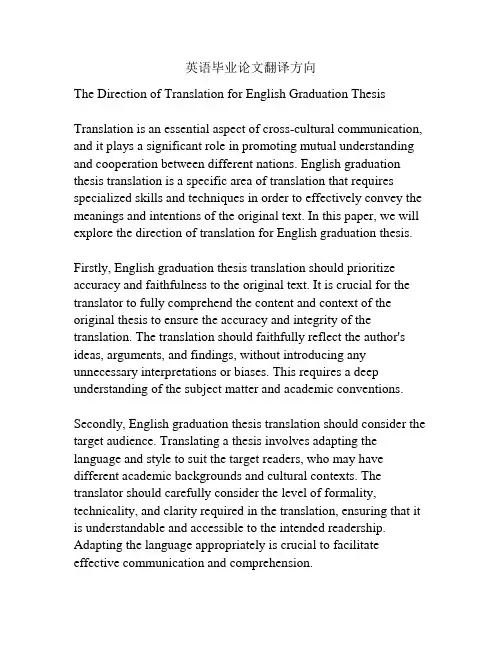
英语毕业论文翻译方向The Direction of Translation for English Graduation ThesisTranslation is an essential aspect of cross-cultural communication, and it plays a significant role in promoting mutual understanding and cooperation between different nations. English graduation thesis translation is a specific area of translation that requires specialized skills and techniques in order to effectively convey the meanings and intentions of the original text. In this paper, we will explore the direction of translation for English graduation thesis.Firstly, English graduation thesis translation should prioritize accuracy and faithfulness to the original text. It is crucial for the translator to fully comprehend the content and context of the original thesis to ensure the accuracy and integrity of the translation. The translation should faithfully reflect the author's ideas, arguments, and findings, without introducing any unnecessary interpretations or biases. This requires a deep understanding of the subject matter and academic conventions. Secondly, English graduation thesis translation should consider the target audience. Translating a thesis involves adapting the language and style to suit the target readers, who may have different academic backgrounds and cultural contexts. The translator should carefully consider the level of formality, technicality, and clarity required in the translation, ensuring that it is understandable and accessible to the intended readership. Adapting the language appropriately is crucial to facilitate effective communication and comprehension.Thirdly, English graduation thesis translation should maintain the original structure and organization of the text. A thesis typically follows a particular structure, including an introduction, methodology, results, discussion, and conclusion. The translator should ensure that the translated thesis follows the same logical flow and organization, allowing readers to navigate and comprehend the content seamlessly. This requires careful attention to detail and meticulous editing to ensure coherence and consistency.Lastly, English graduation thesis translation should be conducted with professionalism and ethical considerations. Translators should comply with ethical guidelines, such as respecting the original author's intellectual property rights and maintaining confidentiality. It is important to cite and reference the original work accurately to avoid any potential plagiarism issues. The translator should also ensure the accuracy of citations and references, as this is crucial for the credibility and academic integrity of the translated thesis.To summarize, the direction of translation for English graduation thesis should prioritize accuracy, consider the target audience, maintain the original structure, and be conducted with professionalism and ethical considerations. By adhering to these principles, translators can effectively convey the meanings and intentions of the original text, facilitating cross-cultural communication and promoting academic exchange.。
关于英语翻译方向的论文范文翻译在跨文化、跨民族之间的交流和合作中功不可没,英语翻译,它既是语言之间的相互转换,同时也是不同文化间的交流。
下文是店铺为大家整理的英语翻译的论文的范文,欢迎大家阅读参考!英语翻译的论文篇1文化空缺与英汉翻译摘要:不同民族的语言产生于不同的文化背景,所承载的文化也不尽相同,这就必然导致两种语言在表达方式上存在很多相异之处,文化空缺就是这些差异的极端表现,它是一个民族语言和文化与其它民族语言和文化的异质性的充分体现,这无疑增加了翻译的难度。
所以文化空缺的翻译不仅是语言的迁移,更是文化的传播。
关键词:文化空缺英汉翻译翻译作为人类最早进行的交流活动之一,一直在不同的语言集团间沟通信息,对人类社会的发展和进步有非常重要的作用。
正是由于翻译所起的中介作用,民族间才可以互通有无、互相学习、共同发展。
跨文化交际学和文化语言学的兴起与发展,为语言与文化的研究带来了勃勃生机。
而作为跨文化交际的翻译,也因此而更加受到重视,对它的研究也呈现出多角度、多侧面、开放性的特点。
翻译作为不同语言之间人们交流思想和文化不可或缺的手段,在传播文化信息、促进不同民族间的相互了解与民族融合的过程中的重要作用已日益凸显。
翻译界对翻译理论研究的重心从译意到译信息再到以文化为导向的翻译,正说明翻译实质是文化的翻译。
如Bassnet & Lefevele就指出翻译的研究实际上就是文化互动的研究,Nida亦强调译者的双文化能力。
而在交流与翻译活动过程中,各民族由于语言文化异质性的客观存在,会不可避免地出现信息交流的障碍。
其中作为语言文化异质性极致体现形式的文化空缺现象更使交流者进入了两难的境地。
为积极应对空缺现象带来的问题,促使交流与翻译的顺利进行,就必须在交流与翻译过程中逐步探寻处理文化空缺的有效途径和办法。
翻译,在古时候叫做“象寄”或“通事”。
《说文解字》里说:“传译四夷之言者。
”《义疏》里也提到:“译即易,谓换易言语使相解也。
翻译英语毕业论⽂范⽂3篇英语毕业论⽂:论功能翻译理论摘要:中国传统翻译理论只有宏观的论述,缺乏⽅法论,操作性不强。
本⽂简述了功能翻译理论,详细地探讨了该理论的理论基础,并⽤关联理论予以论证,丰富了它的内容。
关键词:功能翻译理论;基础理论;阐释Abstract:Chinesetraditionaltranslationtheoryconsistsonlyoftranslationprincipleswithoutconcretemethodologyanditcannotbeappliedtopracticaltranslating.Thispapergivesabriefaccounttofunctionaltranslationtheory,prob Keywords:functionaltranslationtheory;basictheory;exposition功能翻译理论强调,翻译是⼀种特殊的交际形式,涉及三种⽂本:原语⽂本、译者的图式⽂本和译语⽂本。
对于原语⽂本,最重要的是抓住作者的修辞功能正确理解原语的修辞功能,是产⽣理想的图式⽂本的关键。
⽽正确把握原⽂的认知图式⼜是正确理解原⽂修辞功能的基础。
理想的图式⽂本来⾃原⽂的认知图式,来⾃对原⽂作者的修辞意图的准确把握。
在这个图式⽂本的基础上,产⽣怎样的译语⽂本,除了修辞功能等值之外,还应该考虑翻译的⽬的和读者对象。
⼀、功能翻译理论简述(⼀)、功能翻译理论的要点根据杂志上发表的论⽂、学术会议上宣读的论⽂、学术报告和出版的专著,功能翻译理论的要点简述如下:1、分析概念段(conceptualparagraph,具有明确主题意义⼀个或多个⾃然段)和句⼦的修辞功能,使修辞功能的形式重现,从形式的等同中求得功能的等值,意义的等值,这种翻译叫做功能翻译。
翻译应该是在修辞功能等值的前提下,遵守“信、达、X”规范;⽂体不同,翻译的⽬的不⼀样,X不⼀样。
关于英语翻译方向的论文范文(2)英语翻译的论文篇3浅谈职业教育商务英语翻译人才的培养模式0 前言目前对商务英语的培养我们主要是以相关的课程辅导为主,比如说“商务英语翻译”主要阐述的是一些国家的基本的商务模式,以及语言习惯问题,主要是提高人才的商务能力和翻译能力,保障商务英语专业人才能够正确传达客户之间的交流信息,保障双方的利益。
然而由于长期受传统的培养模式的影响,商务英语人才的培养并没有那么容易。
基于这种情况,研究出一套好的商务英语翻译人才培养的方案是很重要的。
1 商务英语人才在培养过程中常见的一些问题以及解决方法就目前而言主要有下列一些问题:人才在培养的过程中教学知识太过于宽泛,缺乏职业的明确性,没有很强的职业观念。
另一类问题就是在教学的过程中太过于书面化缺少实践的锻炼,同时在人才的考核方面也存在很多缺陷,例如考核的标准太过于单一缺少综合性的体现。
这些都是目前所存在的一些问题,针对这些问题我们提出了一些相对应的措施:首先是加强职业观念的培养,要能够做到专业与职业对口,其次就是要加强实践的力度,可以把一些基本的工作任务分配给学生作为教学的主要内容。
最后就是在人才的考核过程中,我们要实现考核的多样化,提高考核的标准,让能力优先者能够有一个好的平台发挥自己的能力。
1.1 人才培养模式的构建人才的培养最终是服务社会的,所以说在人才培养模式的构建过程中我们需要时刻关注社会的动态与走向,以便培养出来的人才能够更好地服务于社会。
人才培养模式的构建需要我们教师通过多年的教学经验和方法的总结才能构建出来的,长时间地比较各种方法,最后留下高效有用的学习方法。
人才培养模式的构建是需要教育者一起来共同努力的。
在培养的过程中我们要以学生为中心,主要是围绕学生展开一系列的教学活动,力求学生能够在短时间内能够学到大量有用的知识。
以职业能力的培养为主导思想,定义专业的能力标准。
教学主要是以实践任务为主,旨在提高人才的职业能力。
石河子大学毕业论文题目:如何处理英翻汉中的省略How to Deal with Ellipsis inEnglish-Chinese Translation院(系):外国语学院专业:英语班级:20095学号:**********姓名:指导教师:完成日期: 2013年5月6日ContentsI.Introduction (1)II. Literature Review (2)III. The Principles of Ellipsis (4)A. Omitted words must be useless and unnecessary in the translated works. 5B. The meaning of the omitted words is implied in the test. (5)C. Omitted words are self-evident. (5)IV. The functions and application of ellipsis (5)A. The Coherence of the Meaning of Expression (6)B. The Coincidence of the Manner of Expression (6)1. Ellipsis of Articles (6)2. Ellipsis of Prepositions (7)3. Ellipsis of Pronouns (7)a. Ellipsis of Personal Pronouns (7)b. Ellipsis of Impersonal Indefinite Pronouns (8)c. Ellipsis of Relative Pronouns (8)4. Ellipsis of Conjunctions (9)a. Ellipsis of Coordinating Conjunctions (9)b. Ellipsis of Subordinate Conjunctions (9)5. Ellipsis of Rhetorics (9)V. Conclusion (10)Works Cited (11)AbstractWith the development of globalization, the world's political, economic and cultural communications are becoming increasingly frequent. Meanwhile, the role of translation cannot be ignored. Due to language and cultural disparity, reasonable translation is particularly important. How to deal with ellipsis in translation is one of the important aspects. The paper will explore ellipsis in English-Chinese translation from five aspects, which are ellipsis of pronouns, conjunctions, articles, prepositions, modifications, so as to achieve the purpose of smoother and clearer communication among China and English-speaking countries.Key words: cultural disparity; translation; ellipsis摘要随着全球化的不断发展,各国之间的政治、经济、文化交流日渐频繁。
关于英语翻译专业毕业论文翻译是指两种不同语言的相互转换,是实现不同文化之间相互交流的关键。
下面是店铺为大家整理的英语翻译专业毕业论文,供大家参考。
英语翻译专业毕业论文范文一:多媒体技术与英语翻译专业教学结合的思考摘要:实践表明,运用互联网进行英语教学可使教学内容化远为近、化虚为实、化静为动、化抽象为具体、化宏观为微观,使英语教学从单一的模式向直观性、趣味性、艺术性和立体化模式发展。
接下来,本文将结合多媒体在英语教学中的作用,探讨多媒体技术与英语翻译课堂教学有效结合的方法以及对策。
关键词:多媒体;翻译;教学;作用;有效结合1前言随着社会的发展以及教育的深入改革,传统教学环境下的教学模式已经不能好地满足社会的发展以及需求,因此,为了更好地改善课堂教学质量,提升课堂教学效果,很多教师开始选择将多媒体技术引入到课堂中来,进而实现多媒体技术与英语翻译课堂教学的有效结合。
我们都知道,多媒体技术本身就具有信息载体多样性的特点,即将文字、文本、图形、图像、视频、语音等多种媒体信息于一体。
这种将书本上的文字以音频、视频或者图画的形式展现出来的功能会使得我们的英语翻译课堂教学变得更加生动形象。
2多媒体在英语翻译课堂教学中的作用2.1激发学生学习兴趣我们都知道,传统的教学环境下,教师大都是凭借书本上的知识照本宣科的进行讲解。
这种书本教学法虽然可以知识教学内容的讲授,但是却使得课堂教学变得十分单调、枯燥,进而导致学生学习兴趣的降低。
我们都知道,多媒体技术具有将文本、文字、图形、视频以及音频进行整合的功能,因此,教师可以将原本课本上的知识以生动形象的形式展现给大家,进而增强课堂的趣味性以及活泼性。
同时,这种生动的教学形式还可以吸引学生的注意力,进而激发学生的学习兴趣。
2.2创建良好的学习氛围传统的教学环境下,教师为了节省课堂的教学时间,大都采用“满堂灌”以及“一言堂”教学模式,与学生之间缺乏一定的互动,进而导致课堂的教学氛围极其沉闷。
英语翻译方向毕业论文I. IntroductionIn recent years, the field of English translation has gained significant attention due to globalization and increased international communication. As a result, the demand for professional English translation services has reached unprecedented levels. This paper aims to explore the challenges and techniques involved in English translation, with a focus on the importance of cultural understanding.II. Challenges in English TranslationTranslating from one language to another is a complex process that involves various challenges. One of the main difficulties in English translation lies in accurately conveying the meaning and nuances of the source text. English is a language rich in idioms, metaphors, and cultural references that may not have direct equivalents in other languages. Translators must find creative ways to capture the essence of these expressions in the target language.Another challenge is maintaining the style and tone of the original text. English literature, for example, encompasses a wide range of writing styles, from formal academic texts to colloquial dialogues. Translators must have a deep understanding of the target audience and the intended effect of the text in order to reproduce the appropriate tone and style.III. Techniques in English TranslationTo overcome the challenges faced in English translation, translators utilize various techniques. These include semantic and syntactic analysis, cultural adaptation, and naturalization.Semantic and syntactic analysis involves a thorough understanding of the source text's structure and meaning. Translators must analyze the sentence structure, word choice, and overall context to accurately convey the intended message. This often requires specialized knowledge in the subject matter to ensure accurate translation.Cultural adaptation is crucial in English translation, as it involves understanding the cultural references and idiomatic expressions that may not exist in the target language. Translators must find suitable equivalents or provide explanations to bridge the cultural gap. This requires extensive research and experience in both the source and target cultures.Naturalization refers to the process of making the translation sound natural and idiomatic in the target language. Translators must consider the linguistic conventions and stylistic preferences of the target language to create a translation that flows smoothly and resonates with the target audience.IV. Importance of Cultural UnderstandingOne of the key aspects of successful English translation is cultural understanding. Language is deeply intertwined with culture, and without proper cultural understanding, translation can lead to misinterpretations and misunderstandings. Translators must familiarize themselves with the cultural context of the source text and make appropriate adjustments to ensure accuracy and appropriateness in the target language.Cultural understanding also extends to the target audience. Translators must consider the cultural norms, beliefs, and preferences of the intended readers to ensure the translation resonates with them effectively. This can include adapting metaphors, using appropriate cultural references, and even adjusting the overall tone of the translation to suit the target audience's cultural expectations.V. ConclusionEnglish translation is a challenging yet essential field that plays a vital role in global communication. Translators must overcome various challenges by utilizing techniques such as semantic and syntactic analysis, cultural adaptation, and naturalization. Additionally, cultural understanding is paramount in achieving accurate and effective translations. Through continuous learning and experience, translators can contribute to bridging the linguistic and cultural gaps in our increasingly interconnected world.。
石河子大学毕业论文题目:如何处理英翻汉中的省略How to Deal with Ellipsis inEnglish-Chinese Translation院(系):外国语学院专业:英语班级:20095学号:**********姓名:指导教师:完成日期: 2013年5月6日ContentsI.Introduction (1)II. Literature Review (2)III. The Principles of Ellipsis (4)A. Omitted words must be useless and unnecessary in the translated works. 5B. The meaning of the omitted words is implied in the test. (5)C. Omitted words are self-evident. (5)IV. The functions and application of ellipsis (5)A. The Coherence of the Meaning of Expression (6)B. The Coincidence of the Manner of Expression (6)1. Ellipsis of Articles (6)2. Ellipsis of Prepositions (7)3. Ellipsis of Pronouns (7)a. Ellipsis of Personal Pronouns (7)b. Ellipsis of Impersonal Indefinite Pronouns (8)c. Ellipsis of Relative Pronouns (8)4. Ellipsis of Conjunctions (9)a. Ellipsis of Coordinating Conjunctions (9)b. Ellipsis of Subordinate Conjunctions (9)5. Ellipsis of Rhetorics (9)V. Conclusion (10)Works Cited (11)AbstractWith the development of globalization, the world's political, economic and cultural communications are becoming increasingly frequent. Meanwhile, the role of translation cannot be ignored. Due to language and cultural disparity, reasonable translation is particularly important. How to deal with ellipsis in translation is one of the important aspects. The paper will explore ellipsis in English-Chinese translation from five aspects, which are ellipsis of pronouns, conjunctions, articles, prepositions, modifications, so as to achieve the purpose of smoother and clearer communication among China and English-speaking countries.Key words: cultural disparity; translation; ellipsis摘要随着全球化的不断发展,各国之间的政治、经济、文化交流日渐频繁。
其中,翻译的作用不可小觑。
由于各国语言文化的差异,合理的翻译就显得尤为重要。
如何处理翻译中的省略是其中一个重要方面。
本文将从代词、连词、冠词、介词、修饰性五个方面的省略探究英翻汉中的省略问题,从而达到中国与英语国家交流更加畅通的目的。
关键词: 文化差异;翻译;省略I. IntroductionWith the development of globalization, the world’s political, economic and cultural communications are becoming increasingly frequent. Therefore, the role of translation cannot be ignored. However, the differences between English and Chinese cultures that are reflected in the two languages pose considerable difficulty.It is acknowledged that when doing translation one cannot translate word for word, or sentence by sentence. Therefore, we must use some translation strategies such as amplification, ellipsis, conversion and so on. Ellipsis as one of the basic translation methods plays an essential role in English-Chinese rendition. Translators apply it in order to make their works more coherent and understandable.According to the Oxford Advanced Learner’s English-Chinese Dictionary, ellipsis means “leaving out a word or words from a sentence deliberately, when the meaning can be understood without them.”Ellipsis in translation does not mean cutting some content from the original texts. What could be omitted are words that are useless in translated works or else they will make the versions redundant or disobey the manner of expression in another language.Some words and phrases are useless in Chinese but necessary in English. Articles in English are the most significant phenomenon from this aspect. They are very important in English, but we can hardly see any reflection of this aspect in Chinese. Ellipsis is designed on the basis of faithfulness to the original text, making it more fluent, smooth, and concise, thus conforming to idiomatic Chinese. In this case, translators apply it in order to make their versions more coherent and better understood. The following two paragraphs analyze the reason why it is so widely used.First of all, Chinese expressions are much briefer than those of English. So ellipsis as part of a special and inseparable translation method is widely used in English-Chinese translation. Generally speaking, a book or a passage which describes the same content in English may be longer in length than that in Chinese, because both English and Chinese have their own characteristics, such as being succinct in language, being abundant in words, being brief in sentences, as well as being flexible in structure. Therefore, brevity brings convenience to our daily communication and usage.Secondly, English grammar is complete in sentence structure. The place ofsubject predicate, object and adjective in a sentence are fixed. A sentence in English consists of the subject and the predicate, no matter how brief it is. Therefore, there must be a large number of link verbs in English. As an integral part of the whole, its function cannot be neglected. Obviously, they are more widely used than that in Chinese. In order to make myself understood, let’s look at the following two sentences.(a). You reap what you sow. 种瓜得瓜,种豆得豆。